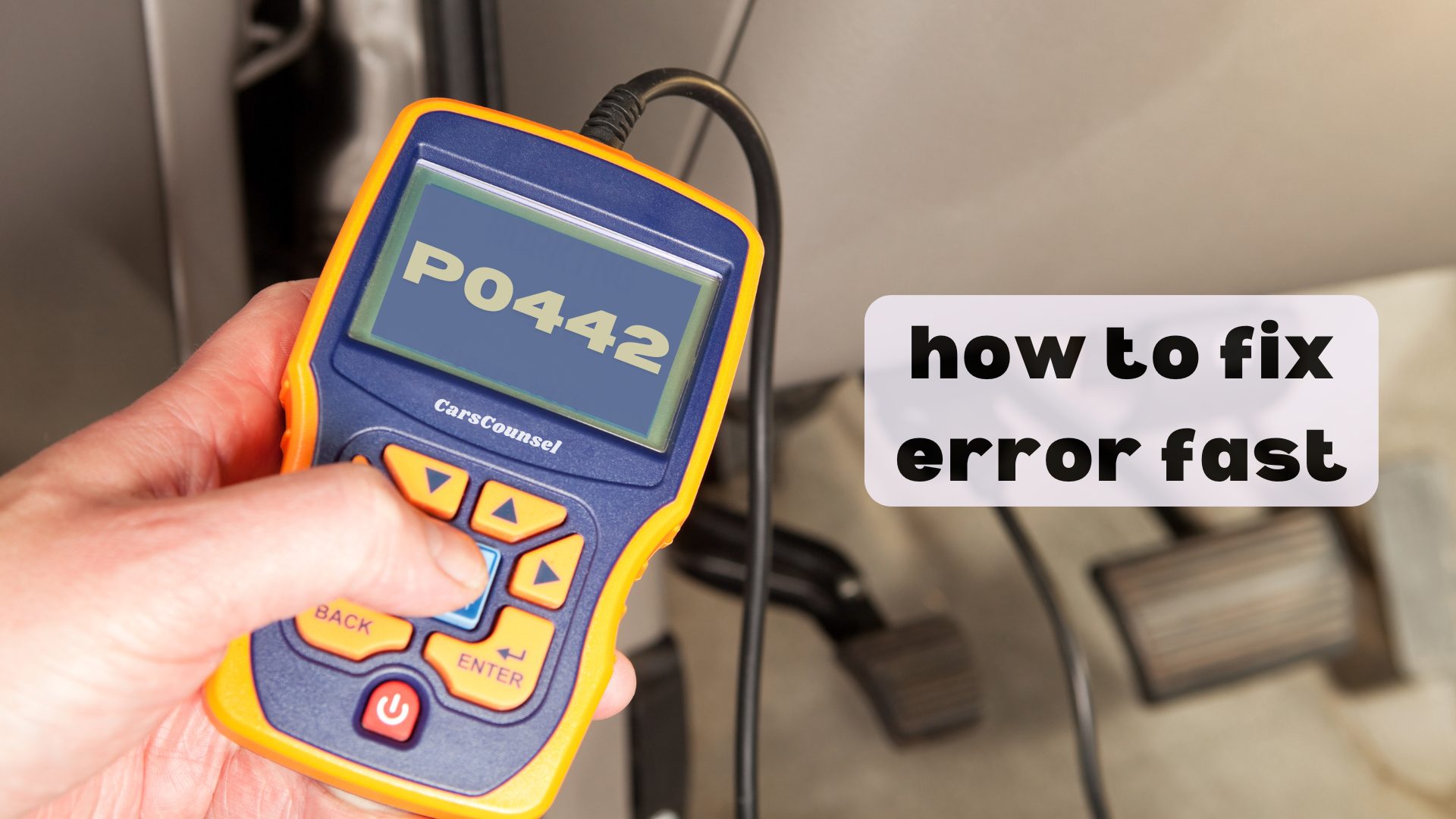Imagine you’re trying to hold water in a leaky bucket – it’s a losing battle. Analogously, when your vehicle’s Evaporative Emission Control System (EVAP) springs a small leak, it’s only a matter of time before the problem grows.
The P0442 code is like the first drop of water escaping, signaling that something’s amiss. But what’s causing the leak, and how can you stop it before it leads to decreased fuel efficiency, increased emissions, and potentially even a failed emissions test? You’re about to find out what’s behind that pesky error code and how to fix it before things get out of hand.

Quick Navigation
Key Takeaways
- A P0442 code indicates a small leak in the Evaporative Emission Control System (EVAP), which can cause decreased fuel efficiency and increased emissions.
- Common causes of a P0442 code include a loose or damaged gas cap, cracked EVAP hoses, a faulty EVAP purge valve, or a leaking EVAP canister.
- Symptoms of a small EVAP leak may include a strong fuel odor, rough idling, stalling, and decreased fuel efficiency, which can lead to emissions test failure.
- To diagnose and fix a P0442 code, inspect and replace damaged components, test the EVAP purge valve and pressure sensor, and consult a mechanic or repair manual as needed.
- Ignoring a P0442 code can lead to decreased fuel efficiency, increased emissions, and potentially even cause the vehicle to fail emissions tests.
Code P0442 Description and Meaning
What does the P0442 code really mean?
It indicates a small leak in the Evaporative Emission Control System (EVAP), which captures fuel vapors from the fuel tank and prevents release into the atmosphere.
A small leak in this system can lead to increased emissions and decreased fuel efficiency. If left unresolved, it can cause your vehicle to fail emissions tests.
The EVAP system is responsible for reducing air pollution, and its history dates back to the 1970s when the US Environmental Protection Agency (EPA) introduced emission control basics to reduce air pollution.
Understanding the EVAP system’s role in emission control is vital in diagnosing and fixing the P0442 code, and it’s essential to address this issue promptly to avoid further complications.
Common Causes of P0442 Code
Your vehicle’s Evaporative Emission Control System (EVAP) is susceptible to various faults that can trigger the P0442 code.
A small leak in the EVAP system can negatively impact your vehicle’s performance and fuel efficiency. You may be wondering what causes this code to appear.
Common culprits include a loose or damaged gas cap, cracked or damaged EVAP hoses, a faulty EVAP purge valve, a leaking EVAP canister, or a malfunctioning EVAP pressure sensor.
Any of these issues can lead to decreased fuel efficiency, increased emissions, and potentially even cause your vehicle to fail emissions tests. Identifying and addressing the root cause of the problem is vital to resolving the P0442 code and restoring your vehicle’s peak performance.
Symptoms of a Small EVAP Leak
When a small leak develops in your Evaporative Emission Control System (EVAP), it can manifest in various ways that affect your vehicle’s performance and overall driving experience. You may notice a strong fuel odor near your vehicle, which can be a sign of a small EVAP leak. This leak can also impact your engine performance, leading to decreased fuel efficiency, rough idling, or stalling.
| Symptom | Description | Impact |
|---|---|---|
| Fuel Odor | Strong smell of gasoline near the vehicle | Decreased air quality, potential health risks |
| Engine Performance Issues | Rough idling, stalling, or difficulty starting | Decreased fuel efficiency, reduced engine power |
| Check Engine Light | Illuminated dashboard light | Notification of a problem, potential emissions test failure |
These symptoms can be indicative of a small EVAP leak, which should be addressed promptly to prevent further damage and potential emissions test failure.
Diagnosing and Fixing P0442
To diagnose and fix the P0442 code, you’ll need to identify the root cause of the small leak in your Evaporative Emission Control System (EVAP).
This leak can lead to decreased fuel efficiency, negative impacts on vehicle performance, and even emissions test failures.
- Inspect the gas cap, EVAP hoses, and canister for signs of damage or wear, and replace them if necessary.
- Test the EVAP purge valve and pressure sensor to verify they’re functioning correctly, and replace them if they’re not.
- Consult a mechanic or repair manual for specific guidance on diagnosing and fixing the P0442 code, as the process may vary depending on your vehicle’s make and model.
Repairing EVAP System Components
Repairing EVAP system components requires attention to detail and a thorough understanding of the system’s intricate workings. You’ll need to identify the faulty component and replace it to prevent further damage. A thorough EVAP system overhaul may be necessary to guarantee all components are functioning properly.
| Component | Symptoms | Repair Action |
|---|---|---|
| Leaky EVAP Canister | Fuel odor, decreased fuel efficiency | Replace EVAP canister |
| Faulty EVAP Purge Valve | Rough idling, stalling | Replace EVAP purge valve |
| Cracked EVAP Hoses | Fuel leaks, decreased fuel efficiency | Replace EVAP hoses |
When replacing leaky components, make sure to follow proper installation procedures to prevent future leaks. Remember to test the EVAP system after repairs to verify it’s functioning correctly.
Cost to Fix P0442 Code Issues
The cost of fixing a P0442 code issue can vary widely, depending on the specific cause of the problem and the labor rates of the mechanic or repair shop you choose.
Your repair estimates will depend on the extent of the damage and the complexity of the repair.
- On average, you can expect to pay between $100 and $500 for parts and labor, but this amount can increase if additional repairs are needed.
- Factors like diagnostic testing and the make and model of your vehicle will also impact the final cost.
Fixing the issue quickly is important, as a small leak in the EVAP system can lead to decreased fuel efficiency and increased emissions, which can harm the environment and your wallet.
Importance of EVAP System Maintenance
Proper maintenance of your vehicle’s Evaporative Emission Control System (EVAP) is vital to prevent issues like the P0442 code from arising in the first place.
By keeping your EVAP system in good condition, you’ll not only avoid costly repairs but also maintain your vehicle’s peak performance. A well-maintained EVAP system guarantees better fuel efficiency, which saves you money on gas and reduces your carbon footprint.
Furthermore, it helps prevent decreased vehicle performance, rough idling, and stalling. Regular checks and maintenance can detect potential problems early on, saving you from more severe issues down the road.
Preventing Future EVAP Leaks
As you tackle the P0442 code, it’s essential to take proactive steps to prevent future EVAP leaks from occurring.
By doing so, you’ll avoid decreased fuel efficiency, increased emissions, and potential emissions test failures.
To prevent future leaks, focus on:
- Regular inspections of the EVAP system, including the gas cap, hoses, and canister, to catch any potential issues early
- Fuel efficiency monitoring to identify any changes that could indicate a developing leak
- Proper maintenance of the vehicle, such as timely oil changes and filter replacements, to reduce the likelihood of EVAP system damage
More OBD-II Codes
| P0444 | P0445 | P0446 | P0447 |
| P0448 | P0450 | P0451 | P0452 |
| P0453 | P0455 | P0456 | P1050 |
| P1017 | P1062 | P1083 | P1084 |
| P1086 | P1088 | P1090 | P1092 |
| P1096 | P1094 | P1098 | P1178 |
Frequently Asked Questions
Can a P0442 Code Cause Damage to Other Vehicle Systems?
You should be aware that a small vapor leak can cause system pressure fluctuations, potentially damaging other vehicle systems, such as the fuel tank, engine, and exhaust systems, if left unchecked.
Will a P0442 Code Trigger a Vehicle Inspection Failure?
You’ll likely fail a vehicle inspection if you’re driving with a P0442 code, as it indicates your vehicle isn’t meeting Emission standards, violating Vehicle regulations, and potentially harming the environment, so it’s essential to address the issue promptly.
Is It Safe to Drive With a P0442 Code Illuminated?
Coincidentally, you’re wondering if it’s safe to drive with the Check Engine Light on – and rightly so! Driving with a small EVAP leak can decrease fuel efficiency, but it’s not an immediate safety risk; however, it’s still important to address the issue to avoid further complications.
Can a Loose Gas Cap Cause Other Trouble Codes?
You might wonder if a loose gas cap can trigger other trouble codes; yes, it can, as it affects fuel pressure, potentially causing vapor leaks that set off codes related to fuel system performance, such as P0455 or P0456.
Will Repairing a P0442 Code Improve Fuel Economy?
You’ll be interested to know that a 10% leak in the EVAP system can increase emissions by up to 50%! By repairing the P0442 code, you can expect improved fuel efficiency, as the EVAP system will capture fuel vapors more effectively, reducing emissions and saving you money at the pump.
Conclusion
As you navigate the complex web of your vehicle’s EVAP system, bear in mind that a small leak can be a ticking time bomb, waiting to trigger a flood of emissions and fuel efficiency issues. Don’t let a tiny crack turn into a major headache – address that P0442 code promptly, and keep your EVAP system running like a well-oiled machine. With regular maintenance and attention, you can prevent future leaks and keep your vehicle purring smoothly.

